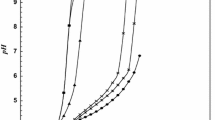Abstract
By using the isothermal titration calorimetry (ITC) technique, thermodynamic parameters have been determined for reactions of the Mg2+, Ca2+, Sr2+, and Ba2+ ions with the citrate anion. The measurements were run in the Cacodylate, Pipes and Mes buffer solutions of a pH of 6, at 298.15 K, as well as in the Tricine, Tapso, and Tris–HCl buffer solutions of a pH of 8. Further, based on the results of potentiometric titration, the conditional stability constants were determined for the citrate complexes at both pH values. The effect of the reaction environment and the metal ion identity on the interaction energy with the citrate ligand and the stability of the resulting compounds have been discussed.


Similar content being viewed by others
References
Martin RB. Citrate binding of Al3+ and Fe3+. J Inorg Biochem. 1989;28:181–7.
Beinert H, Kennedy MC. Engineering of protein bound iron-sulfur clusters. A tool for the study of protein and cluster chemistry and mechanism of iron-sulfur enzymes. Eur J Biochem. 1989;186:5–15.
Lippard SJ. Principles of bioinorganic chemistry. Mill Valley, CA: University Science Books; 1994. p. 352.
Sheldrick B. Calcium hydrogen citrate trihydrate. Acta Crystallogr B. 1974;30:2056–7.
Zacharias DE, Glusker JP. Structure of strontium citrate pentahydrate. Acta Crystallogr C. 1993;49:1732–9.
Matzapetakis M, Karligiano N, Bino A, Dakanali M, Raptopoulou CP, Tangoulis V, Terzis A, Giapintzakis J, Salifoglou A. Manganese citrate chemistry: syntheses, spectroscopic studies, and structural characterizations of novel mononuclear, water-soluble manganese citrate complexes. Inorg Chem. 2000;39:4044–51.
Zhou Z-H, Deng Y-F, Wan H-L. Structural diversities of cobalt(II) coordination polymers with citric acid. Cryst Growth Des. 2005;5:1109–17.
Predoana L, Malic B, Zaharescu M. LaCoO3 formation from precursors obtained by water-based sol-gel method with citric acid. J Therm Anal Calorim. 2009;98:361–6.
Waqas H, Quresh AH. Influence of pH on nanosized Mn–Zn ferrite synthesized by sol-gel auto combustion process. J Therm Anal Calorim. 2009;98:355–60.
da Silva MFP, de Souza Carvalho FM, da Silva Martins T, de Abreu Fantini MC, Isolani PC. The role of citrate precursors on the morphology of lanthanide oxides obtained by thermal decomposition. J Therm Anal Calorim. 2010;99:385–90.
Deng Y-F, Zhou Z-H, Cao Z-X, Tsai K-R. Speciation and transformation of Co(II)/Ni(II)–citrate–imidazole ternary system—synthesis, spectroscopic and structural studies. J Inorg Biochem. 2004;98:1110–6.
Bates RG, Pinching GD. Resolution of the dissociation constants of citric acid at 0 to 50, and determination of certain related thermodynamic functions. J Am Chem Soc. 1949;71:1274–83.
Levien BJ. A physicochemical study of aqueous citric acid solutions. J Phys Chem. 1955;59:640–4.
Glusker JP, van der Helm D, Love WE, Dornberg ML, Minkin JA, Johnson CK, Patterson AL. X-ray crystal analysis of the substrates of aconitase. VI. The structures of sodium and lithium dihydrogen citrates. Acta Crystallogr. 1965;19:561–72.
Holcomb M, Strumpel M, Butler WM, Nordman CE. A crystallographic study of the phase transition in rubidium dihydrogen citrate. Acta Crystallogr B. 1987;43:313–8.
Gabe EJ, Glusker JP, Minkin JA, Patterson AL. X-ray crystal analysis of the substrates of aconitase. VII. The structure of lithium ammonium hydrogen citrate monohydrate. Acta Crystallogr. 1967;22:366–75.
Zacharias DE, Glusker JP. Structure of a citrate double salt: potassium dihydrogen citrate-lithium potassium hydrogen citrate monohydrate. Acta Crystallogr C. 1993;49:1727–30.
Martin RB. A complete ionization scheme for citric acid. J Phys Chem. 1961;65:2053–5.
Strouse J. Carbon-13 NMR studies of ferrous citrates in acidic and alkaline solutions. Implications concerning the active site of aconitase. J Am Chem Soc. 1977;99:572–80.
Strouse J, Layten SW, Strouse CE. Structural studies of transition metal complexes of triionized and tetraionized citrate. Models for the coordination of the citrate ion to transition metal ions in solution and at the active site of aconitase. J Am Chem Soc. 1977;99:562–72.
Glusker JP. Citrate conformation and chelation: enzymatic implications. Acc Chem Res. 1980;13:345–52.
Carrell HL, Glusker JP, Piercy EA, Stallings WC, Zacharias DE, Davis RL, Astbury C, Kennard CHL. Metal chelation versus internal hydrogen bonding of the.alpha.-hydroxy carboxylate group. J Am Chem Soc. 1987;109:8067–71.
Brandariz I, Barriada J, Vilarino T, Sastre de Vicente M. Comparison of several calibration procedures for glass electrodes in proton concentration. Monatsh Chem. 2004;135:1475–88.
Kostrowicki J, Liwo A. A general method for the determination of the stoichiometry of unknown species in multicomponent systems from physicochemical measurements. Comput Chem. 1987;11:195–210.
Al-Khaldi MH, Nasr-El-Din HA, Mehta S, Al-Aamri AD. Reaction of citric acid with calcite. Chem Eng Sci. 2007;62:5880–96.
Baker BM, Murphy KP. Evaluation of linked protonation effects in protein binding reactions using isothermal titration calorimetry. Biophys J. 1996;71:2049–55.
Fukada H, Takahashi K. Enthalpy and heat capacity changes for the proton dissociation of various buffer components in 0.1 M potassium chloride. Proteins. 1998;33:159–66.
Haq I, O’Brien R, Lagunavicius A, Siksnys V, Ladbury JE. Specific DNA recognition by the type II restriction endonuclease MunI: the effect of pH. Biochemistry. 2001;40:14960–7.
Goldberg RN, Kishore N, Lennen RM. Thermodynamic quantities for the ionization reactions of buffers. J Phys Chem Ref Data. 2002;31:231–70.
Hunt JP. Metal ions in aqueous solution. Amsterdam: W. A. Benjamin. Inc.; 1965.
Kiriukhin MY, Collins KD. Dynamic hydration numbers for biologically important ions. Biophys Chem. 2002;99:155–8.
Acknowledgements
This research was supported by the Polish Ministry of Science and Higher Education under Grant DS/8230-4-0088-10.
Author information
Authors and Affiliations
Corresponding author
Rights and permissions
About this article
Cite this article
Wyrzykowski, D., Czupryniak, J., Ossowski, T. et al. Thermodynamic interactions of the alkaline earth metal ions with citric acid. J Therm Anal Calorim 102, 149–154 (2010). https://doi.org/10.1007/s10973-010-0970-y
Received:
Accepted:
Published:
Issue Date:
DOI: https://doi.org/10.1007/s10973-010-0970-y




